Brother Bear
Reviewed by: Caroline Mooney
CONTRIBUTOR
| Moral Rating: | Average |
| Moviemaking Quality: |
|
| Primary Audience: | Kids |
| Genre: | Animation Kids Family |
| Length: | 1 hr. 25 min. |
| Year of Release: | 2003 |
| USA Release: |
November 1, 2003 |

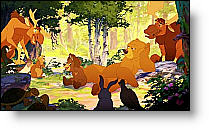
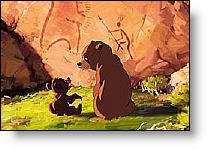
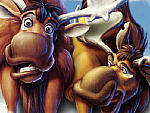
Native American Indian mysticism
“Circle of life” theme
Communication with dead ancestors
Shaman says that the “spirits of our ancestors have power to make changes”
What is DEATH? and WHY does it exist? Answer in the Bible
What is ETERNAL LIFE? and what does the Bible say about it?
What is ETERNAL DEATH?
BEARS in the Bible
Animals of the Bible
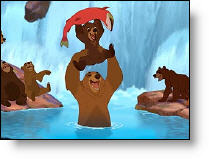
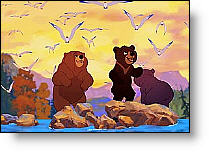
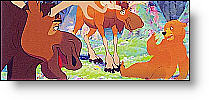
| Featuring |
|---|
|
Joaquin Phoenix Rick Moranis Michael Clarke Duncan Pauley Perrette Jeremy Suarez Dave Thomas Joan Copeland |
| Director |
|
Aaron Blaise Bob Walker |
| Producer |
|
Chuck Williams II |
| Distributor |
Let’s face it, Walt Disney productions set the standard for animation films. Anticipating the bells and whistles big budgets afford, we look forward to Disney movies. “Brother Bear” delivers catchy tunes, no-expense-spared animation, an epic story, and of course, a moral lesson. Not unlike the film “Pocahontas,” “Brother Bear” is loaded with anti-Christian “spiritual truths.”
Set in the Pacific Northwest some 10,000 years before the Europeans settled in America, three Native American brothers, Kenai, Denahi and Sitka enjoy life within the security of their tribe. After a day of fishing, the brothers return to the village to attend an important religious ceremony. Kenai, preparing to enter manhood, eagerly awaits his gift, a chosen symbol determined by the Great Spirits, to adorn his neck and change his destiny.
The charm, believed to direct the destiny of its wearer, is taken very seriously. When Kenai receives his token of love, in the form of a bear, resentment and disappointment set in. Believing the bear to be a thief and destroyer of mankind, the young Indian boy, Kenai, vows to prove his manhood by hunting down and killing the bear who ambled into camp to steal some fish.
Through some mystical action of the Great Spirit, possibly to teach him a lesson, Kenai changes from the hunter to the hunted; he becomes a bear. When Denahi sees a bear and discovers his brother’s possessions, he fears Kenai is dead. Unaware that the bear is actually his own brother, Denahi determines to kill the bear. Kenai, unable to communicate to his brother, must run for his life. His destination—the place where the lights dance on the mountains, a sacred Indian ground.
On the way, Kenai meets Koda, a talkative, young bear cub who is lost from his mother and completely alone. Not really wanting a tag-a-long at first, Kenai acquiesces to the cubs request to come along, but only because Koda claims to know the way to the sacred spot, the one place Kenai desperately desires to find. Also along the way, Kenai discovers talking animals, a tradition with Disney, and a wise old bear. Fortunately, none of the characters burst into song. Instead, Disney went all out, commissioning Phil Collins to provide the singing.
In real life, few people have the opportunity to literally walk in someone else’s shoes; however, it happens often in the movies, “Freaky Friday,” both the old and new version for instance. Forced to roam the land as a bear, Kenai ultimately understands that bears are not enemies of man, but simply animals doing what they must to survive.
Also true to Disney form, the film layers humor and special effects to please both young and old viewers. Children will love Koda and the talking animals. Adults will appreciate the music of Phil Collins and the hilarious commentary provided by Rick Moranis and Dave Thomas, voices of the comic moose duo. Additionally, although “Brother Bear” is not a production of previous epic proportions, say the “Lion King,” for example, it is an entertaining film with the usual high quality animations, humor, and a few warm and fuzzy moments.
Concerns
Of concern to me is the Indian mysticism and “circle of life” thematic core of the film. Some critics might argue that the Great Spirit is God-like, but the spiritual tale includes communication with dead ancestors, tokens as destiny shapers, and equality of man and nature, common elements of Indian legends and directly opposed to God’s Word.
It could be argued that Disney is merely closely following the traditions of Indian legends, and most likely they are. However, parents may want to discuss the mixture of ancestor worship, mysticism, and Hinduism presented as a feel-good story of loyalty and friendship. According to the myth of the Great Spirit, we are all part of the great circle of life. Specifically, when we die, we become part of the Great Spirit, god-like and omnipresent.
The Shaman, for example, says that the “spirits of our ancestors have power to make changes,” and that Kenai will have to make restitution with his dead brother before the Great Spirits will change him back into a person again. Moreover, the Great Spirits, the collective body of our dead ancestors and all other dead creatures, guide us and direct our destiny. This might sound to some like the telling of some harmless Indian legend, but to many people, particularly those not fully grounded in God’s Word, it is a nice way to say that everybody goes to some wonderful place after death and that our goodness ultimately makes us as gods.
What bothers me most about the movie “Brother Bear” is the not so subtle theme, that we are all “brothers”. Innocent sounding but completely unbiblical, is the idea that people are as valuable as animals, and that we all end up in the same vaguely defined place after death. According the book of Genesis, God clearly created man to rule over the Earth; man and beast do not share the same status in the eyes of God.
Parents need not worry about language. There is no cursing or vain use of the Lord’s name; however, some childlike name-calling peppers the dialogue for comic relief. The brothers tease each other as siblings often do. Insults such as “dog breath,” “Pine cone breath,” and “fat head” are exchanged. Some birds “poop” when flying. Otherwise, the language is clean and acceptable for children to hear.
There is one reference to alcohol, though it was over the heads of my children. One moose tells his brother they should celebrate the happy ending with a “cool bed of hops.”
A few scenes are quite intense, but this is not surprising considering the nature of hunting. Some hunters, for example, trap a bear. One bear, while charging a man, lunges into a spear. The audience sees the dead bear lying on the ground. In two other scenes, one of Kenai’s brothers falls into a dangerously raging river, and the other falls into a crevice. Kenai and Koda must flee from Kenai’s angry brother, but of course, the brother has no idea he is trying to kill his own sibling. The brothers clearly love each other; in fact, Sitka lays down his own life by triggering a huge landslide to spare Kenai from the spear of his other brother.
Conclusion
On a positive note, viewers of “Brother Bear” witness the reconciliation of the moose brothers, the sacrifice of one life to protect another life, and Kenai’s desire to make atonement for killing Koda’s mother. Though there are some good one-liners and a few moral lessons to bring home, the film’s emphasis on spiritual mysticism is of mammoth proportions and of grave concern to me. I urge parents to discuss the concepts of the Great Spirit, the circle of life, and “destiny”—before, during, and after viewing this film.
Violence: Moderate / Profanity: None / Sex/Nudity: None


The movie offers strong Cristian values such as Love your enemy and vengeance is wrong. The overall theme of the movie “We (humans and animals) are all brothers, is also an important biblical truth that man in this utilitarian society of ours often forget. Yes, God did give man dominion over the animals, but headship is NOT superiority: “There is an eventuality of man as there is an eventuaity of animal. As one dies, so the other dies; they all have the samespirit, so there is no superiority of man over beast, for everything is vanity.” Eccl. 3:19-21 Overall, I would highly recomend “Brother Bear” to one and all.
[SLIGHTLY Objectionable / 4]
[Average/3]
[Average / 3]
My main problem is the spirituality. The idea of becoming like God upon death with “great spirits” is pure heresy and the exact lie Satan told Eve before the fall of man. When people die in real life, one of the two things happen: The saved go to Heaven, eternally present with God and eternally far from sadness, sickness, death, and pain. The unsaved go to perdition, eternally separated from God and eternally far from joy, health, comfort, and relief. In the end, “Brother Bear” and its direct-to-video sequel are indirect heresy packages.
Are there some good things in this movie and the sequel? Yes, there are: Most of the songs are beautiful, brotherly love is promoted, a young woman conquers her fear (in the sequel), and forgiveness amongst peers is glorified. Such a shame morals like the ones I just mentioned were used for a movie like this. The animals could also be viewed as promoting the good stewardism that God gave Adam in Genesis, but it’s sadly overshadowed by the idea of animal ghosts running the world. Pray for every soul involved in this movie.
Moral rating: Offensive / Moviemaking quality: 3
[Very Offensive/2]
[Better than Average/3]
[Average/4]
[Offensive/2]
[Very Offensive / 2]
[Somewhat Offensive / 2]
[Extremely Offensive/5]
[Better than Average/1]
[Better than Average/5]
[Better than Average/5]
[Better than Average / 5]
[SLIGHTLY Objectionable / 5]
[SLIGHTLY Objectionable / 1]
[Better than Average/3]
[Average/3]
The story is one of spiritual growth/self-discovery. The movie only misses an excellent rating as the spiritual path of discovery is attuned to another religion. While unidentified, it would seem the movie takes place in Alaska and features Eskimos. The Eskimo religion in the film is based on a form of animalism. All animals, including people, have a spirit. When they die, they go to live in the sky (in the Aurora Borealis.) These spirits are guardians of the living and are able to do magic by transforming matter. For instance, the spirits can create flowers on the side of a snow-covered mountain.
The story features three brothers, who are apparently orphans. The oldest brother asks as father. At the age of 12, in their culture, the priestess goes to the mountain where the spirits touch the Earth to discover which spirit is the guardian of the youth. According to this tradion, Kenai (key-nigh) (the youngest brother) is given the guardian totem (in the form a necklace) of the Bear, which is symbolic of love. His task it to follow the path of his totem to become a man.See all »
[Good/4]
Kenai finds out that Koda was separated from his mother and plans on meeting her at the Salmon Run, a yearly gathering place for bears where they fish and tell the stories of their journeys to their friends. Since the mountain where Kenai is headed is close to the Salmon Run, Kenai reluctantly agrees to allow Koda to travel with him. At first, Koda annoys Kenai, but eventually they become close friends and even consider themselves to be brothers. Nevertheless, the happiness is soon interrupted when Kenai discovers the horrible truth about Koda’s mother. Kenai feels so terrible about what happened to her that he runs away and soon crosses paths with Denahi again. There is yet another life-and-death struggle between bear and human with an outcome that I will leave for you to discover yourself.See all »
[Better than Average/5]



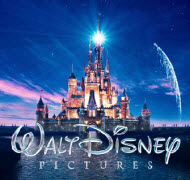
My Ratings: [Good / 4]